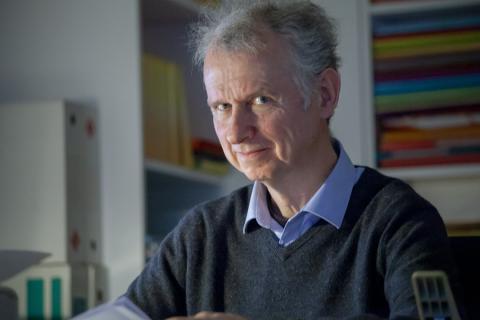
Jean-François Le Gall – a strange sort of menu for a mathematician
A member of the French Academy of Sciences, mathematician Jean-François Le Gall is a specialist in the theory of probability. He was recently awarded the prestigious Wolf Prize 2019 in mathematics for performing research that has decisively advanced the field of random geometry. Specifically, he is the first mathematician to have constructed the Brownian map, discovering the universal law that governs the properties of large graphs randomly drawn in the plane.
Jean-François Le Gall is Director of the Probability and Statistics Group at the Orsay Mathematics Laboratory (LMO – CNRS/Université Paris-Sud) and Principal Investigator for Project GeoBrown, funded by an ERC Advanced Grant awarded by the European Research Council. He is working on several aspects of probability, establishing mathematical models that account for random phenomena (stochastic processes). "I grew interested in Brownian motion, a fundamental object of probability theory, because it is involved in so many problems," observes Jean-François Le Gall.
Weiner sausages
The Brownian motion, named after Robert Brown, the botanist and microscopist who first observed this random process, is also known as the Wiener process in honor of mathematician Norbert Wiener, whose peers today like to spice things up with a pun or two. Their name for objects appearing in the theory of Brownian motion is "Wiener sausages", a specialty that has been on Jean-François Le Gall's research "menu" since the 1980s.
"Let's take a particle suspended in water. Highly agitated, it constantly changes direction. This disorderly, highly irregular movement whose direction cannot be predicted, is modeled by Brownian motion." Jean-François Le Gall has devoted extensive study to its multiple points, especially those through which the motion passes an infinite number of times, obtaining remarkable new properties. "I imagined Brownian movement leaving a trace in its wake. By thickening the curve a little, I was able to get very precise information on the volume of all of the points visited."
The law of chance
Jean-François Le Gall's recent findings on the theory of random graphs, the result of five years of work, are one of the reasons for which he is being honored today. "Imagine traveling across the Earth, drawing roads (edges) completely randomly between cities (vertices) until the entire surface is covered. Once this random geometric model has been created, the distances from one point to another are measured." Observing the infinite limit of the graph, the mathematician was able to show the unicity of the model. "Admittedly, the model is random, but it is also universal by virtue of its law. For instance, one can calculate the probability that the maximum distance between two points on the sphere will be larger than a fixed quantity."
Concrete applications
"It does not feel like I am working on abstract matters", says Jean-François Le Gall. "The models that I deal with are very close to those studied by theoretical physicists. In the past, Brownian motion was often used in mathematical finance, and is still used today." The study of probability theory, long neglected in France, developed progressively over the past six decades and, since 2006, has given rise to three Fields medals. Jean-François Le Gall mentions this trend, noting modestly that it probably explains why he received the Wolf Prize for mathematics, "a great source of satisfaction" and an honor shared with fellow mathematician Gregory Lawler.
A passion for mathematics
At age 22, after graduating from École Normale Supérieure, Jean-François Le Gall joined the French National Centre for Scientific Research (CNRS). "I do not know what I would have done if I had not gotten the job, because I wanted nothing more than to go into research," he recalls. He became a professor at Université Pierre et Marie Curie, where he taught for twenty years, then joined the Orsay Mathematics Laboratory in 2007. Today, nearly 40 years later, Jean-François Le Gall has quite a track record, with about 130 publications to his credit, 10 international conferences a year and the supervision of about 20 theses.
Giving young people a leg up
Jean-François Le Gall encourages students to pursue their passion despite having to face fierce competition. "It is gratifying to help them make progress in mathematics research, problem-solving and articles writing," he remarks. "Research work is often a solitary business, so I am happy to do something tangible to help others." His attentiveness to students has not gone forgotten. The guest list for his 60th birthday party next June includes 300 researchers, all fervent Brownians!

